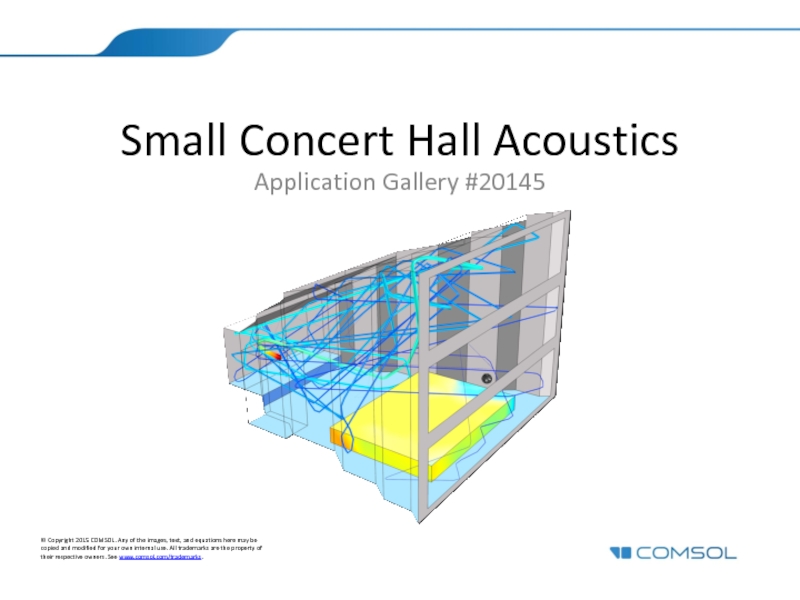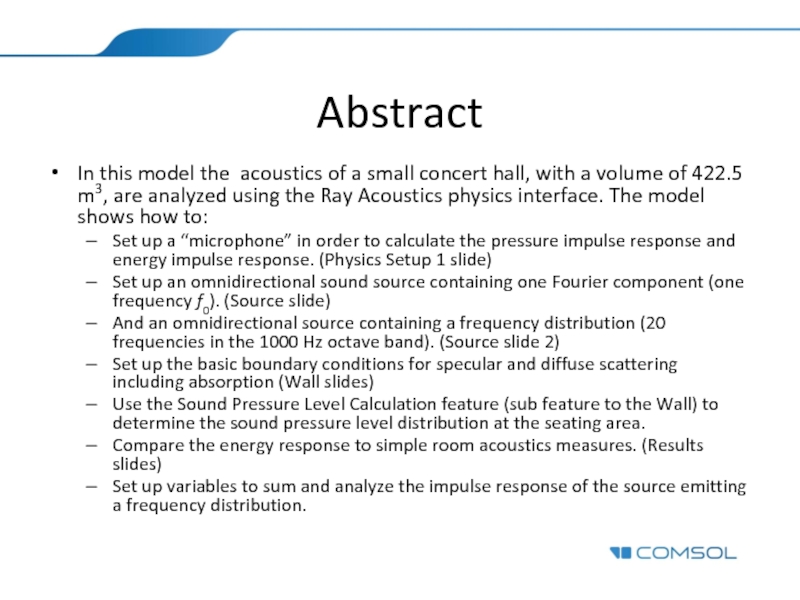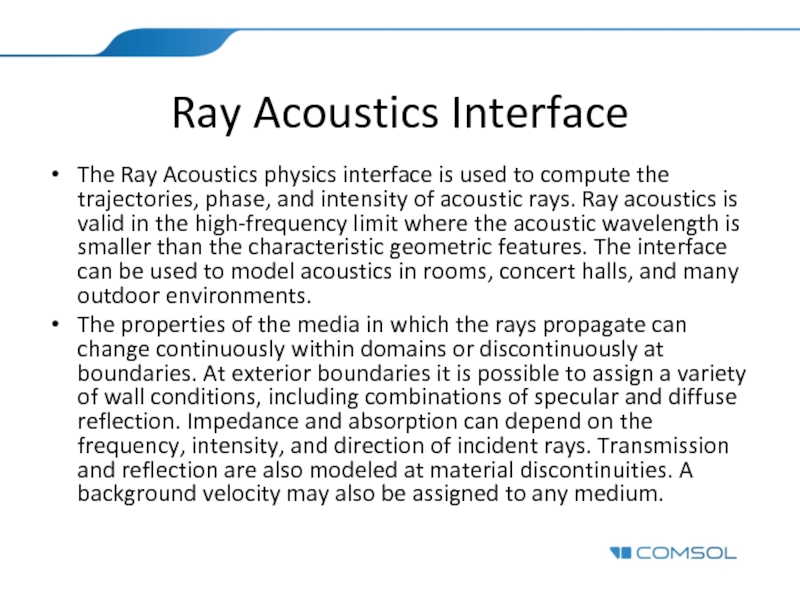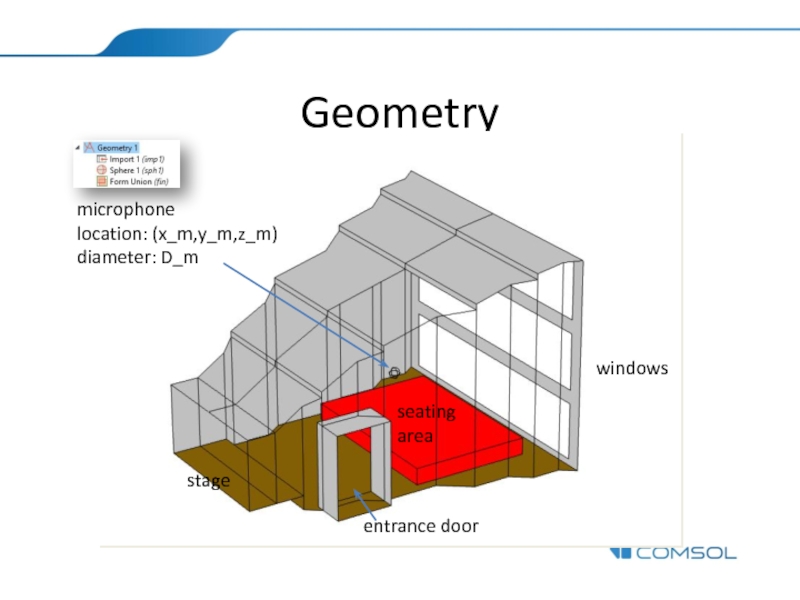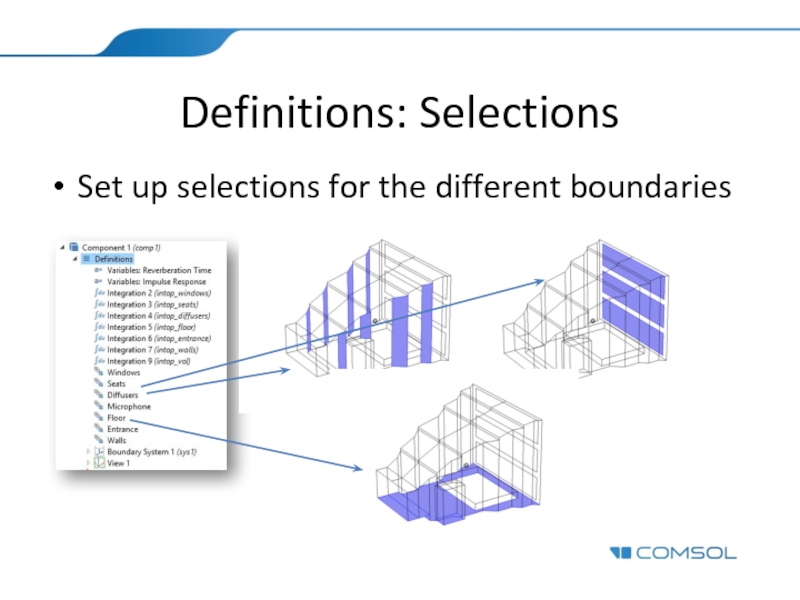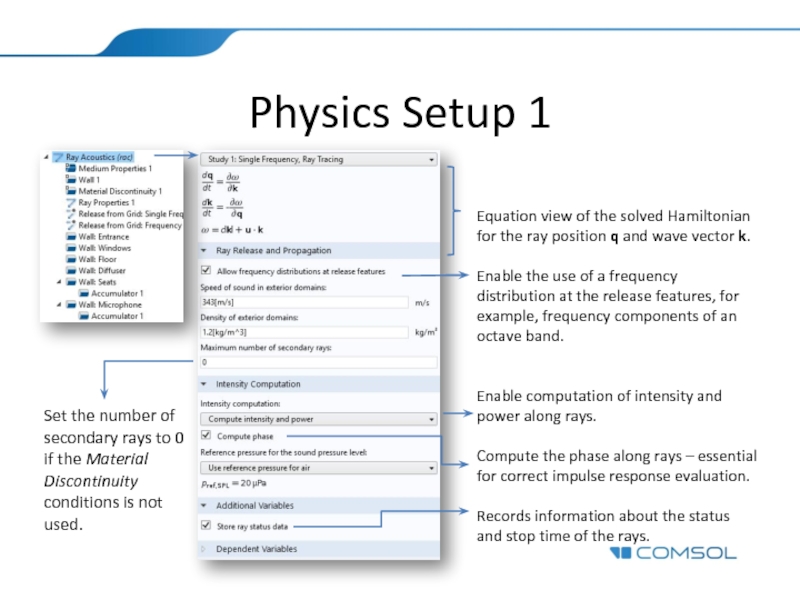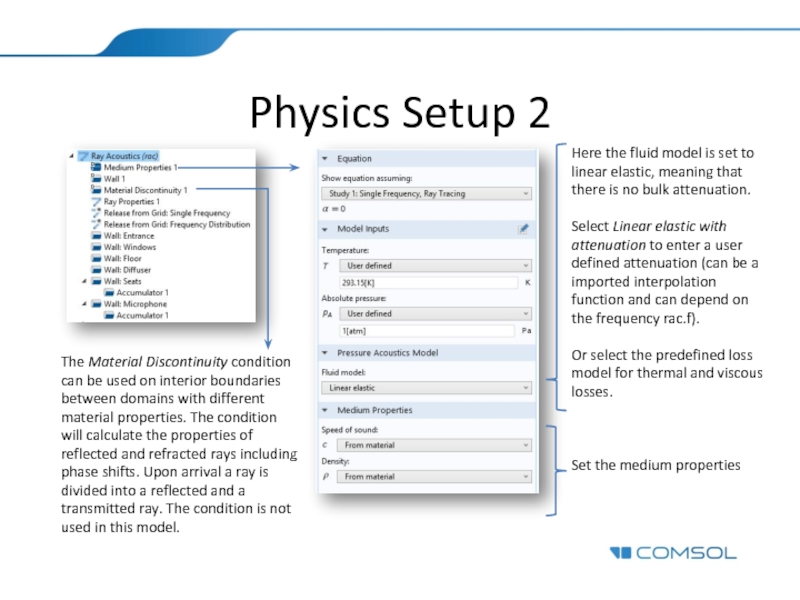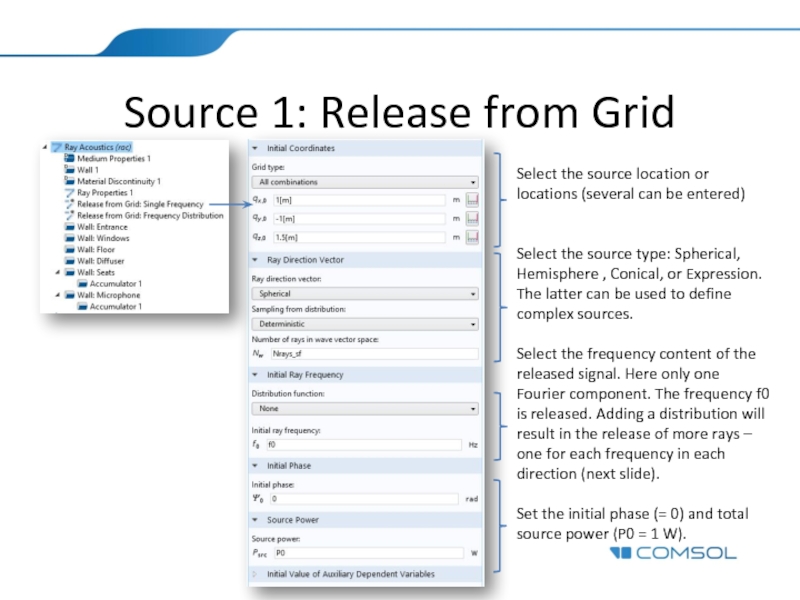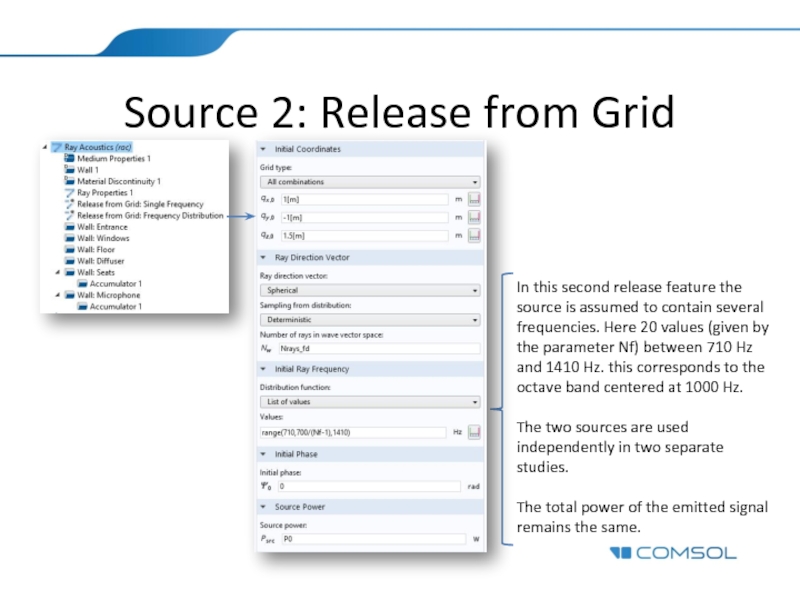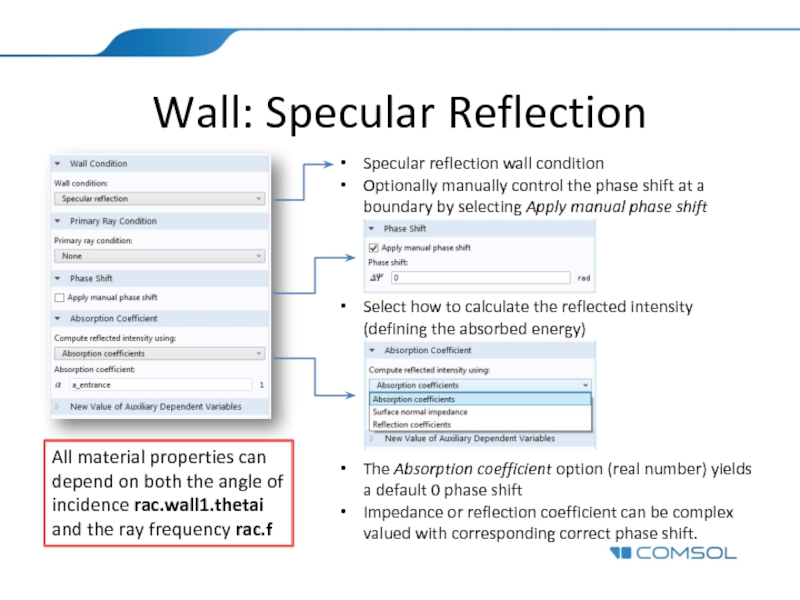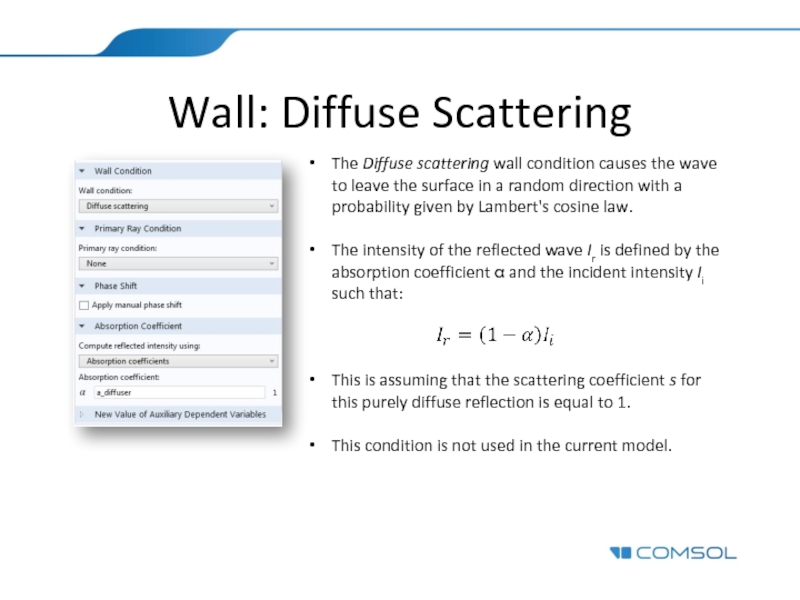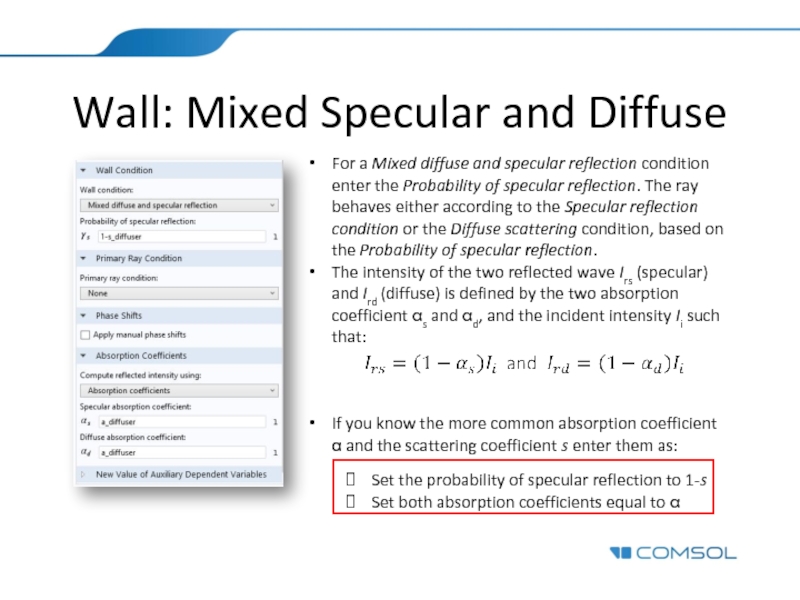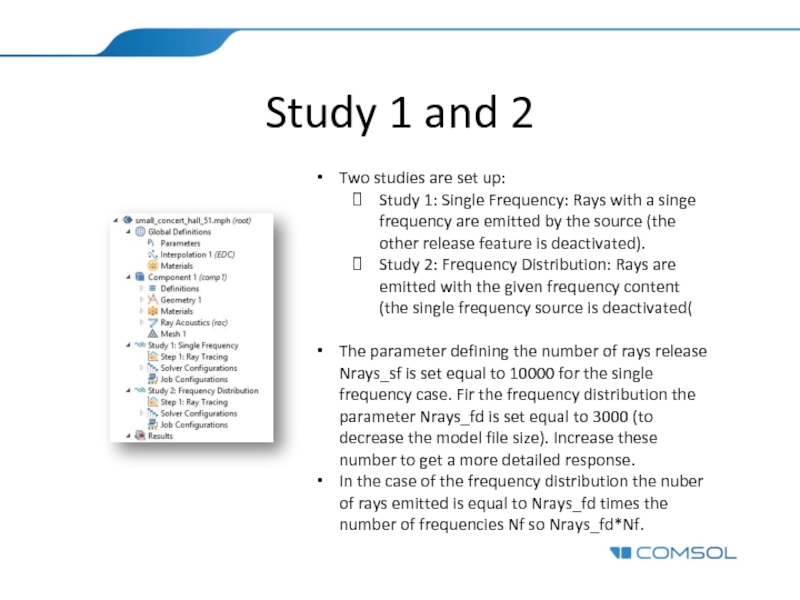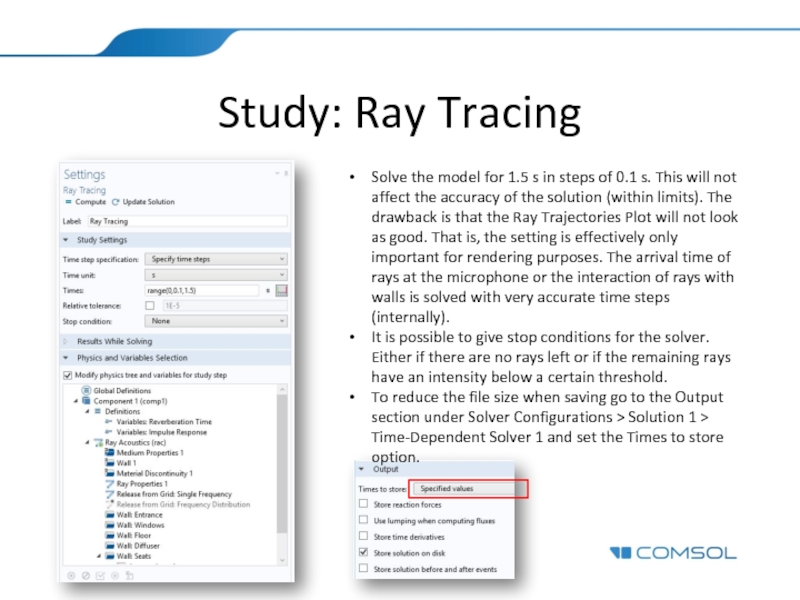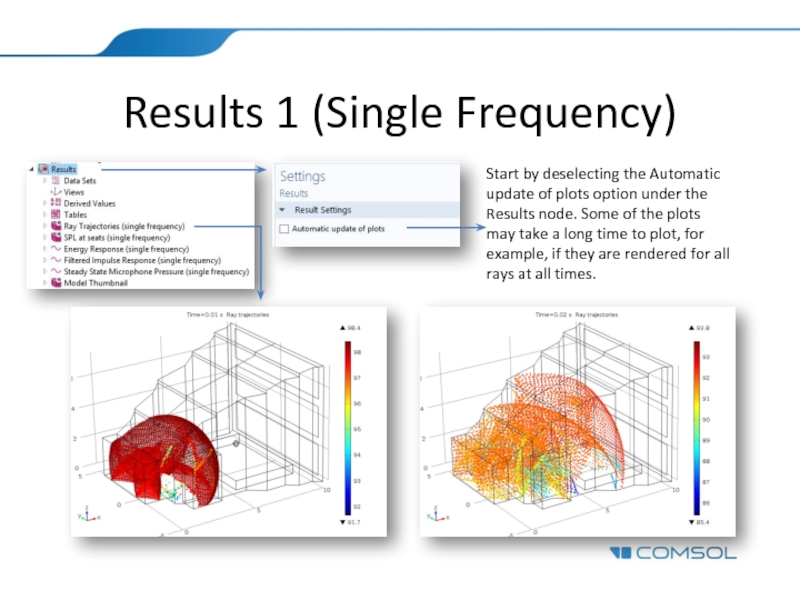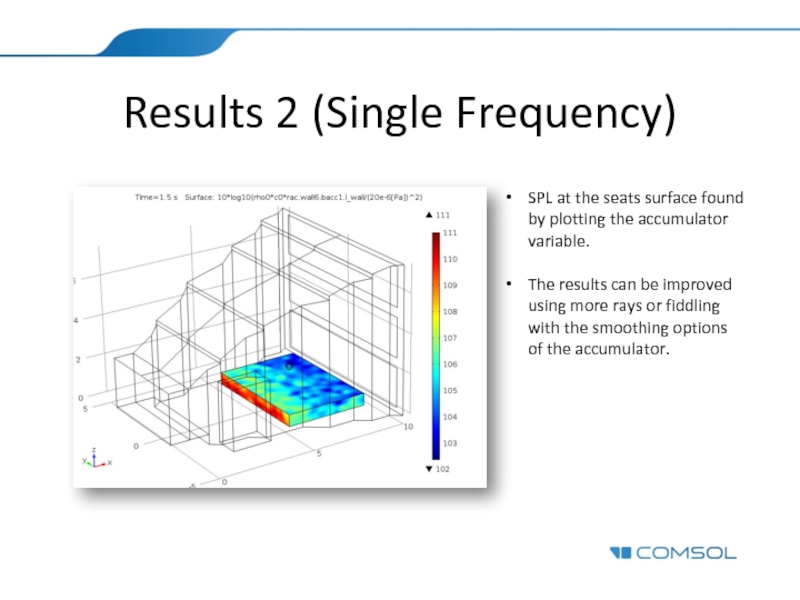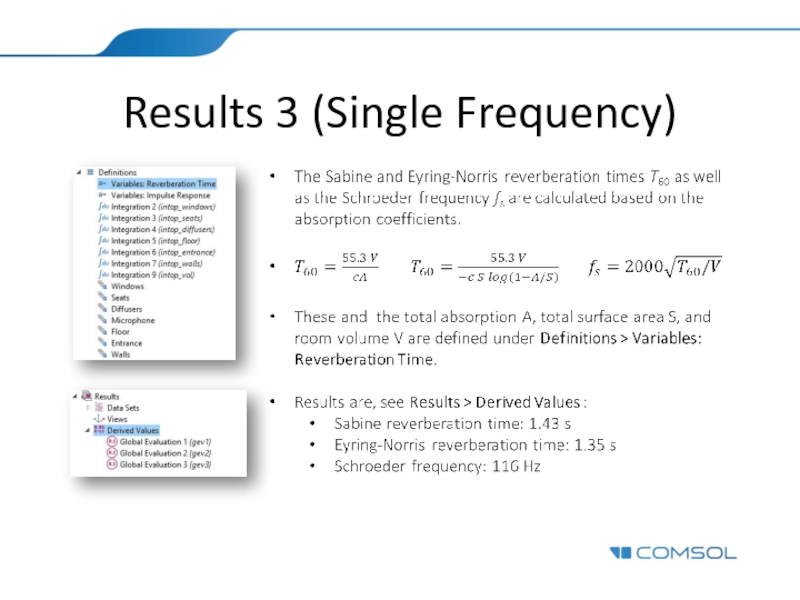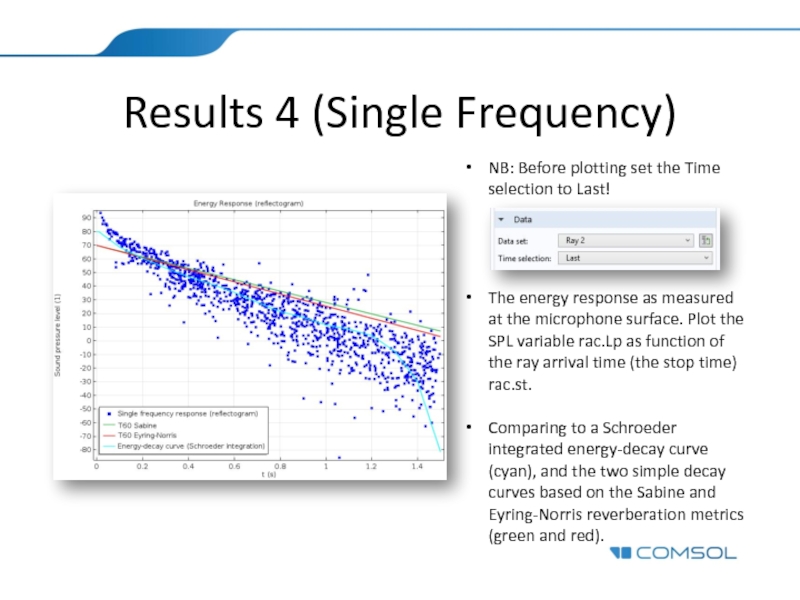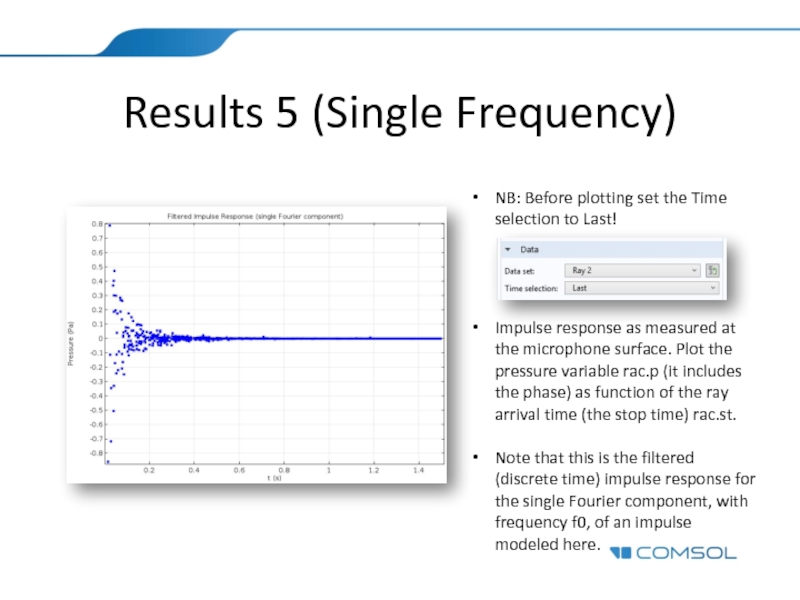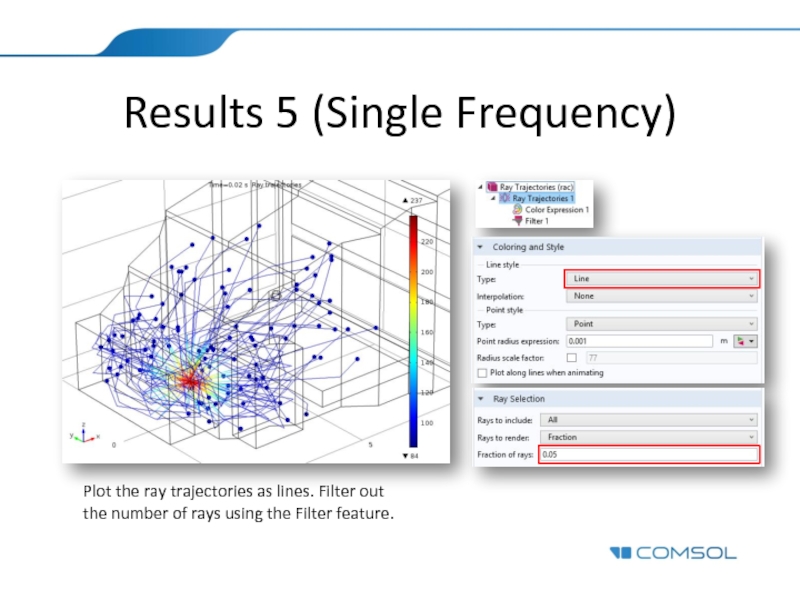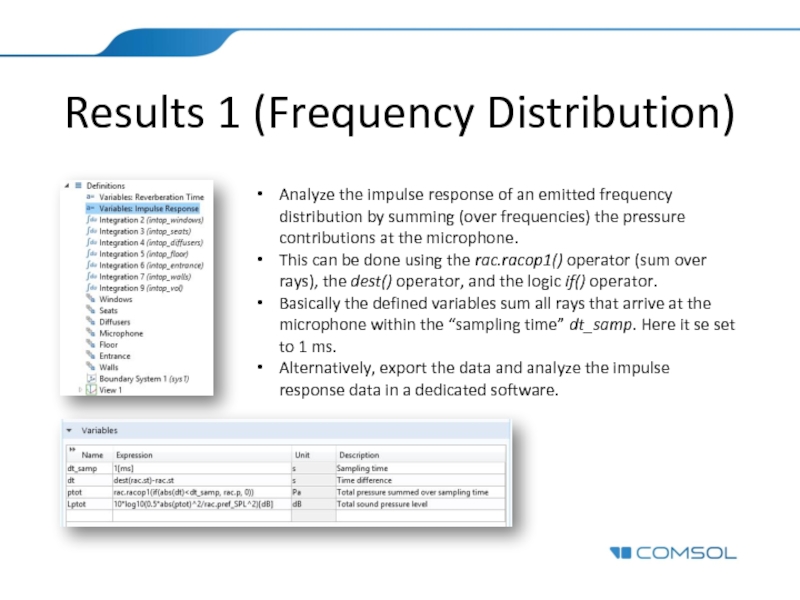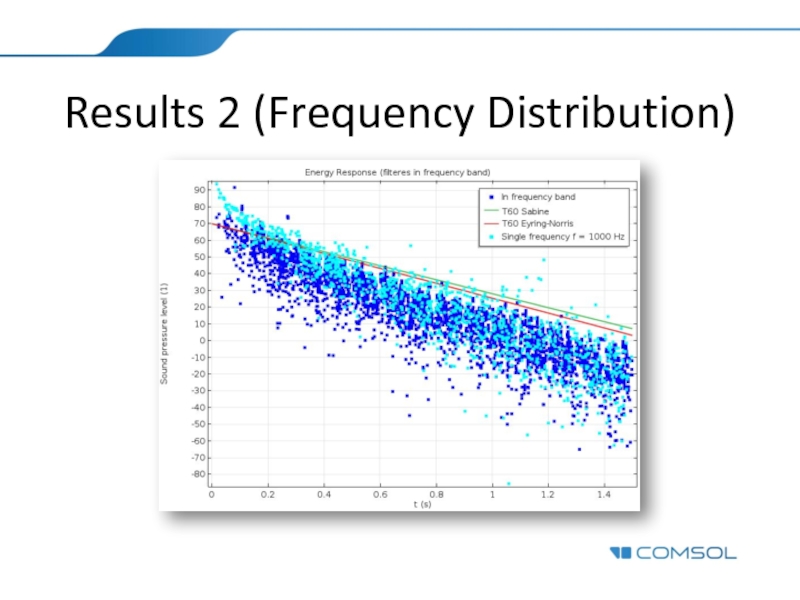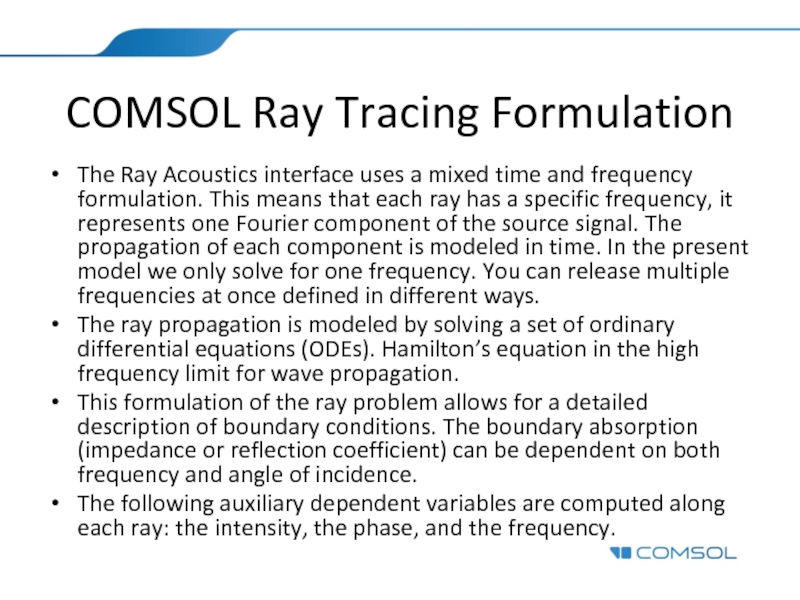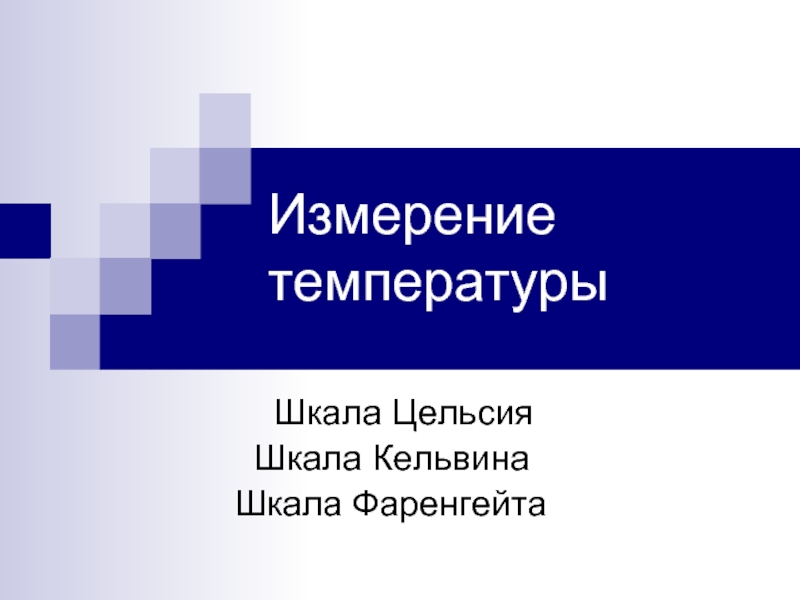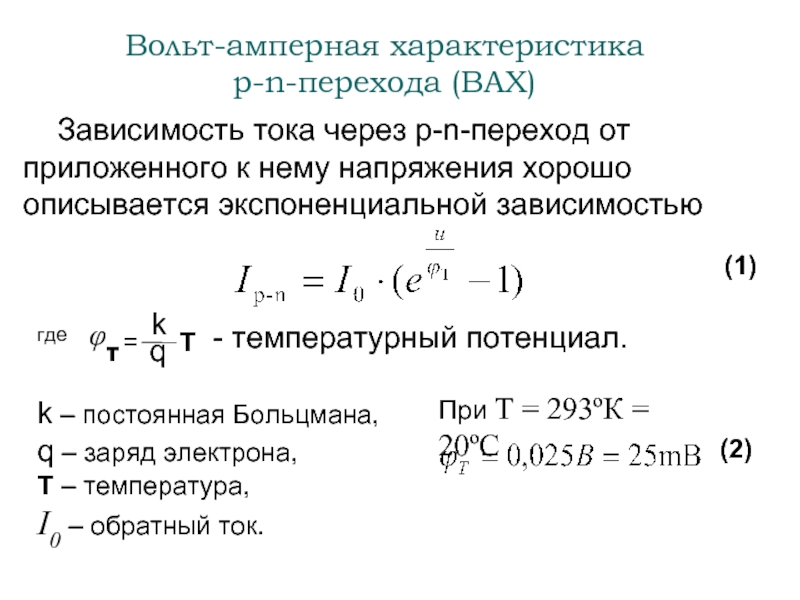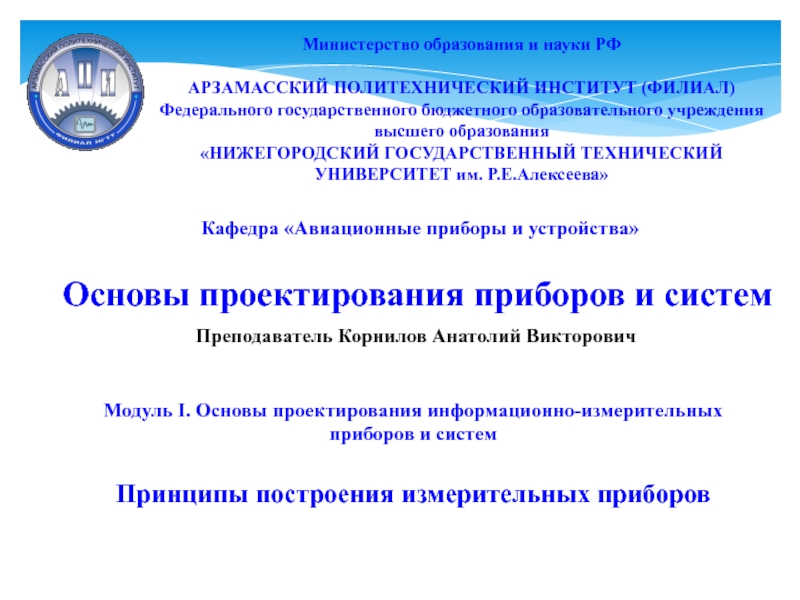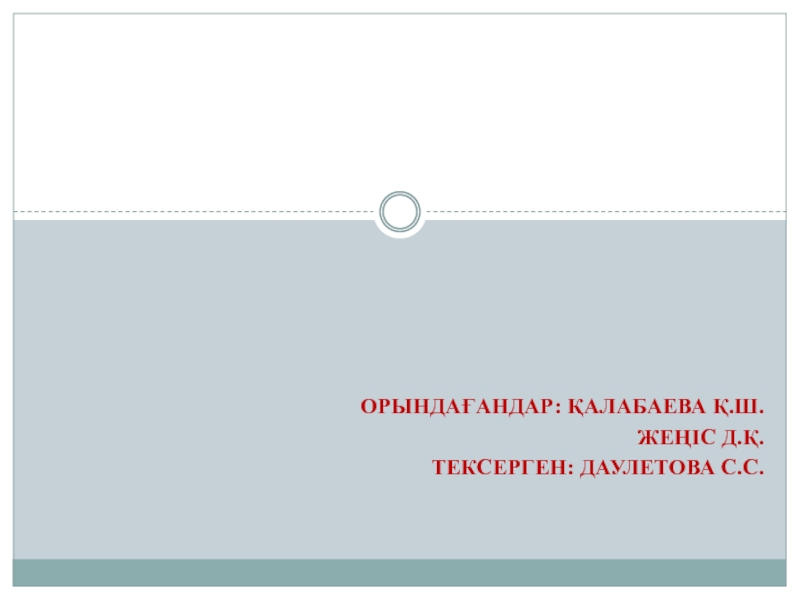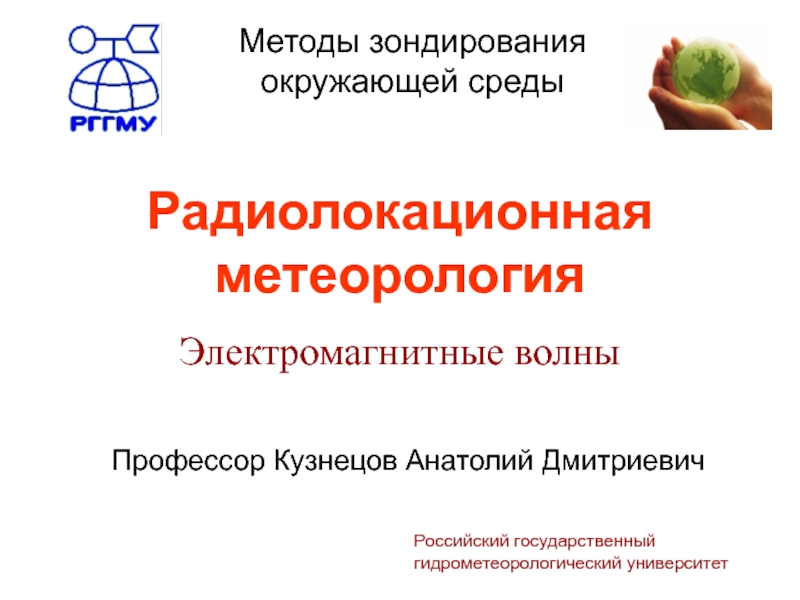- Главная
- Разное
- Дизайн
- Бизнес и предпринимательство
- Аналитика
- Образование
- Развлечения
- Красота и здоровье
- Финансы
- Государство
- Путешествия
- Спорт
- Недвижимость
- Армия
- Графика
- Культурология
- Еда и кулинария
- Лингвистика
- Английский язык
- Астрономия
- Алгебра
- Биология
- География
- Детские презентации
- Информатика
- История
- Литература
- Маркетинг
- Математика
- Медицина
- Менеджмент
- Музыка
- МХК
- Немецкий язык
- ОБЖ
- Обществознание
- Окружающий мир
- Педагогика
- Русский язык
- Технология
- Физика
- Философия
- Химия
- Шаблоны, картинки для презентаций
- Экология
- Экономика
- Юриспруденция
Small Concert Hall. Acoustics презентация
Содержание
- 1. Small Concert Hall. Acoustics
- 2. Abstract In this model the acoustics of
- 3. Ray Acoustics Interface The Ray Acoustics physics
- 4. Geometry windows seating area stage microphone location: (x_m,y_m,z_m) diameter: D_m entrance door
- 5. Definitions: Selections Set up selections for the different boundaries
- 6. Set the number of secondary rays to
- 7. Physics Setup 2 The Material Discontinuity
- 8. Source 1: Release from Grid Select the
- 9. Source 2: Release from Grid In this
- 10. Wall: Specular Reflection Specular reflection wall condition
- 11. Wall: Diffuse Scattering The Diffuse scattering wall
- 12. Wall: Mixed Specular and Diffuse For a
- 13. Study 1 and 2 Two studies are
- 14. Study: Ray Tracing Solve the model for
- 15. Results 1 (Single Frequency) Start by deselecting
- 16. Results 2 (Single Frequency) SPL at the
- 17. Results 3 (Single Frequency)
- 18. Results 4 (Single Frequency) NB: Before plotting
- 19. Results 5 (Single Frequency) NB: Before plotting
- 20. Results 5 (Single Frequency) Plot the ray
- 21. Results 1 (Frequency Distribution) Analyze the impulse
- 22. Results 2 (Frequency Distribution)
- 23. COMSOL Ray Tracing Formulation The Ray Acoustics
Слайд 2Abstract
In this model the acoustics of a small concert hall, with
Set up a “microphone” in order to calculate the pressure impulse response and energy impulse response. (Physics Setup 1 slide)
Set up an omnidirectional sound source containing one Fourier component (one frequency f0). (Source slide)
And an omnidirectional source containing a frequency distribution (20 frequencies in the 1000 Hz octave band). (Source slide 2)
Set up the basic boundary conditions for specular and diffuse scattering including absorption (Wall slides)
Use the Sound Pressure Level Calculation feature (sub feature to the Wall) to determine the sound pressure level distribution at the seating area.
Compare the energy response to simple room acoustics measures. (Results slides)
Set up variables to sum and analyze the impulse response of the source emitting a frequency distribution.
Слайд 3Ray Acoustics Interface
The Ray Acoustics physics interface is used to compute
The properties of the media in which the rays propagate can change continuously within domains or discontinuously at boundaries. At exterior boundaries it is possible to assign a variety of wall conditions, including combinations of specular and diffuse reflection. Impedance and absorption can depend on the frequency, intensity, and direction of incident rays. Transmission and reflection are also modeled at material discontinuities. A background velocity may also be assigned to any medium.
Слайд 6Set the number of secondary rays to 0 if the Material
Physics Setup 1
Equation view of the solved Hamiltonian for the ray position q and wave vector k.
Enable the use of a frequency distribution at the release features, for example, frequency components of an octave band.
Enable computation of intensity and power along rays.
Compute the phase along rays – essential for correct impulse response evaluation.
Records information about the status and stop time of the rays.
Слайд 7Physics Setup 2
The Material Discontinuity condition can be used on interior
Here the fluid model is set to linear elastic, meaning that there is no bulk attenuation.
Select Linear elastic with attenuation to enter a user defined attenuation (can be a imported interpolation function and can depend on the frequency rac.f).
Or select the predefined loss model for thermal and viscous losses.
Set the medium properties
Слайд 8Source 1: Release from Grid
Select the source location or locations (several
Select the source type: Spherical, Hemisphere , Conical, or Expression. The latter can be used to define complex sources.
Select the frequency content of the released signal. Here only one Fourier component. The frequency f0 is released. Adding a distribution will result in the release of more rays – one for each frequency in each direction (next slide).
Set the initial phase (= 0) and total source power (P0 = 1 W).
Слайд 9Source 2: Release from Grid
In this second release feature the source
The two sources are used independently in two separate studies.
The total power of the emitted signal remains the same.
Слайд 10Wall: Specular Reflection
Specular reflection wall condition
Optionally manually control the phase shift
Select how to calculate the reflected intensity (defining the absorbed energy)
The Absorption coefficient option (real number) yields a default 0 phase shift
Impedance or reflection coefficient can be complex valued with corresponding correct phase shift.
All material properties can depend on both the angle of incidence rac.wall1.thetai
and the ray frequency rac.f
Слайд 11Wall: Diffuse Scattering
The Diffuse scattering wall condition causes the wave to
The intensity of the reflected wave Ir is defined by the absorption coefficient α and the incident intensity Ii such that:
This is assuming that the scattering coefficient s for this purely diffuse reflection is equal to 1.
This condition is not used in the current model.
Слайд 12Wall: Mixed Specular and Diffuse
For a Mixed diffuse and specular reflection
The intensity of the two reflected wave Irs (specular) and Ird (diffuse) is defined by the two absorption coefficient αs and αd, and the incident intensity Ii such that:
If you know the more common absorption coefficient α and the scattering coefficient s enter them as:
Set the probability of specular reflection to 1-s
Set both absorption coefficients equal to α
Слайд 13Study 1 and 2
Two studies are set up:
Study 1: Single Frequency:
Study 2: Frequency Distribution: Rays are emitted with the given frequency content (the single frequency source is deactivated(
The parameter defining the number of rays release Nrays_sf is set equal to 10000 for the single frequency case. Fir the frequency distribution the parameter Nrays_fd is set equal to 3000 (to decrease the model file size). Increase these number to get a more detailed response.
In the case of the frequency distribution the nuber of rays emitted is equal to Nrays_fd times the number of frequencies Nf so Nrays_fd*Nf.
Слайд 14Study: Ray Tracing
Solve the model for 1.5 s in steps of
It is possible to give stop conditions for the solver. Either if there are no rays left or if the remaining rays have an intensity below a certain threshold.
To reduce the file size when saving go to the Output section under Solver Configurations > Solution 1 > Time-Dependent Solver 1 and set the Times to store option.
Слайд 15Results 1 (Single Frequency)
Start by deselecting the Automatic update of plots
Слайд 16Results 2 (Single Frequency)
SPL at the seats surface found by plotting
The results can be improved using more rays or fiddling with the smoothing options of the accumulator.
Слайд 18Results 4 (Single Frequency)
NB: Before plotting set the Time selection to
The energy response as measured at the microphone surface. Plot the SPL variable rac.Lp as function of the ray arrival time (the stop time) rac.st.
Comparing to a Schroeder integrated energy-decay curve (cyan), and the two simple decay curves based on the Sabine and Eyring-Norris reverberation metrics (green and red).
Слайд 19Results 5 (Single Frequency)
NB: Before plotting set the Time selection to
Impulse response as measured at the microphone surface. Plot the pressure variable rac.p (it includes the phase) as function of the ray arrival time (the stop time) rac.st.
Note that this is the filtered (discrete time) impulse response for the single Fourier component, with frequency f0, of an impulse modeled here.
Слайд 20Results 5 (Single Frequency)
Plot the ray trajectories as lines. Filter out
Слайд 21Results 1 (Frequency Distribution)
Analyze the impulse response of an emitted frequency
This can be done using the rac.racop1() operator (sum over rays), the dest() operator, and the logic if() operator.
Basically the defined variables sum all rays that arrive at the microphone within the “sampling time” dt_samp. Here it se set to 1 ms.
Alternatively, export the data and analyze the impulse response data in a dedicated software.
Слайд 23COMSOL Ray Tracing Formulation
The Ray Acoustics interface uses a mixed time
The ray propagation is modeled by solving a set of ordinary differential equations (ODEs). Hamilton’s equation in the high frequency limit for wave propagation.
This formulation of the ray problem allows for a detailed description of boundary conditions. The boundary absorption (impedance or reflection coefficient) can be dependent on both frequency and angle of incidence.
The following auxiliary dependent variables are computed along each ray: the intensity, the phase, and the frequency.
